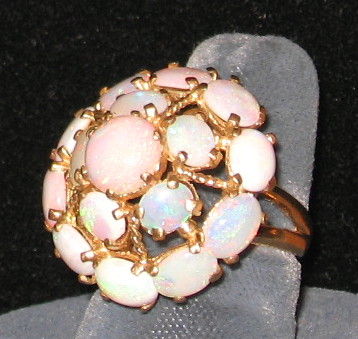“I believe I admire them (semi-precious stones) even more than precious stones, for among them . . . we have only the four obvious colours, but here—why there is not a colour on land or sea but is imprisoned in one of these heavenly stones.”
Oscar Wilde made that comment about 120 years ago, and he must have had opals in mind. Before that time, the opal, birthstones for the month of Oct., was relatively scarce in jewelry.
But as the turn of the century approached opals were becoming wildly popular, as they would again in the mid-20th century, and as they are again right now.
The word opal comes from the ancient Sanskrit, “upala,” which simply means jewel. Perhaps this is because the iridescent quality of the opal makes it appear to be the mother of all jewels, containing all their colors at once.
Opals are so mesmerizing, they have long been believed to be magical.
The ancient Greeks and Romans associated the opal with eyesight, and believed that those who wore or carried an opal would be protected from the unexpected, because they would be able to see into the future. Arabs believed opals were formed by lightning trapped in the earth.
Unlike so many other semi-precious gems, the opal isn’t a quartz or a crystal, but a silicate (jelly) formed from decaying rock and ground water and hardened in layers over time.
Each opal is about 50 million years old. Its layers make it very fragile, which probably accounts for its rarity in Victorian jewelry. But those layers also diffract the light, and that diffusion is the opal’s fire—an explosion of green, blue, aqua, red and yellow.
In 1902 when Louis Comfort Tiffany, the famous designer and glass artist, took over the family jewelry business on Fifth Ave. in New York City, he almost immediately set about making opal jewelry.
And when he created 27 special pieces for sale at the Louisiana Purchase Exhibition in St. Louis in 1904, nearly half of them were made with opals.
Tiffany knew how the Edwardians loved all things iridescent—peacock feathers, mother of pearl, his own “favrile” glass, the inexpensive “carnival glass” and a favorite of the period, opalescent glass, where glass items were trimmed in milk glass.
Most opals shimmer with color. Jewelers sometimes classify them as “harlequin,” “church window’” “peacock,” and “flame.”
The “fire” opal, also called the Mexican opal, is ablaze with reds and oranges. The boulder opal gets its metallic sheen from its iron content.
The water opal, which is supposed to be colorless, actually ripples with shades of white. Even the black opal contains elements of blue, gray, and green.
—Arthur Schwerdt, a certified appraiser, is the author of The Antique Story Book: Finding the Real Value of Old Things,” and co-owner of The August Farmhouse Antiques on Route 9 in Swainton. Send your comments, questions and appraisal requests to aschwerdt@cmcherald.com.






